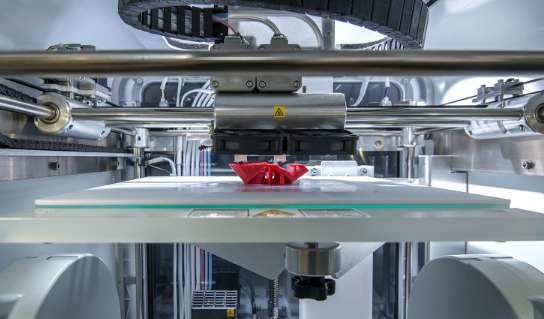 If you get in at the beginning of a new technology or major trend, often there is time to enjoy that wonderful euphoric window of time while it’s still slightly lawless and unfettered, allowing for almost secret and infinite opportunity. But if you’re hearing a screeching sound in the distance just now—well, that’s some of your fun coming to a halt.
If you get in at the beginning of a new technology or major trend, often there is time to enjoy that wonderful euphoric window of time while it’s still slightly lawless and unfettered, allowing for almost secret and infinite opportunity. But if you’re hearing a screeching sound in the distance just now—well, that’s some of your fun coming to a halt.
While the party certainly isn’t over in terms of 3D printing, a lot more people have shown up to enjoy the technology and see what it can do for them as well. Unfortunately, that’s when you need to start looking over your shoulder, according to a team of cybersecurity and materials engineers at the NYU Tandon School of Engineering.
Remember when all you had to worry about was suffering a crime in person? It’s much more complicated than that these days as criminals enjoy the online and cyber world just as much as we do—only sometimes these days they are lurking in the shadows just hoping to do some damage—and often for no good reason at all. We have all either been affected by viruses, malware, online fraud issues, or know someone who has by now, most likely. You can carry that right on over to 3D printing now, as outlined in a recent paper just published in JOM, the journal for the Minerals, Metals and Materials Society, with some research funding coming from the Office of Naval Research.
In, ‘Manufacturing and Security Challenges in 3D Printing’ by Steven Eric Zeltmann, Nikhil Gupta, Nektarios Georgios Tsoutsos, Michail Maniatakos, Jeyavijayan Rajendran, and Ramesh Karri, the researchers contend that there are potential security dangers out there in the 3D printing realm, just as the rest of your online world.
“The risks posed are examined through mechanical testing of objects with altered printing orientation and fine internal defects,” state the research team in their paper. “Finite element analysis and ultrasonic inspection are also used to demonstrate the potential for decreased performance and for evading detection. The results highlight several scenarios, intentional or unintentional, that can affect the product quality and pose security challenges for the additive manufacturing supply chain.”
Likening these issues to those of current day security challenges with electronics, they warn that you can run into trouble during printing orientation and insertion of fine defects.
“These are possible foci for attacks that could have devastating impact on users of the end product, and economic impact in the form of recalls and lawsuits,” said Nikhil Gupta, materials researcher and an associate professor of mechanical engineering at the New York University Tandon School of Engineering.
Basically, while anyone could be as risk, there is also great concern in terms of other very important components—or top secret ones—that are being 3D printed in areas of industry like aerospace. A cyberterrorist could potentially hack in and begin altering a design or print as one is working on it digitally.
“With the growth of cloud-based and decentralized production environments, it is critical that all entities within the additive manufacturing supply chain be aware of the unique challenges presented to avoid significant risk to the reliability of the product,” said cybersecurity researcher Karri. “New cybersecurity methods and tools are required to protect critical parts from such compromise.”
As the team began evaluating the 3D printing process and how it could potentially be affected by a lack of security, they began experimenting by placing sub-millimeter defects between printed layers. These tiny errors could not be picked by normal monitoring like ultrasonic imaging, but in time the materials do begin to weaken due the normal elements which they are exposed.
“With 3D printed components, such as metallic molds made for injection molding used in high temperature and pressure conditions, such defects may eventually cause failure,” Gupta said.
So, while no one may notice at first, their point is that a sneaky cyberhacker could cause a defect without your knowing it, and then patiently walk away knowing that the 3D printed part would come apart over time upon being subjected to sunlight, humidity, temperature differences, and more.
How a product is oriented results in as much as a 25 percent difference in strength, the researchers pointed out. Those hoping to ‘alter’ a 3D print could indeed do so in a sneaky fashion, but the researchers say that in order to safeguard something like this from happening, you should attempt to use as little material as possible, while printing as many parts as possible all in one operation—greatly lowering your chances for trouble. Does this worry you? Let’s talk about it more over in the 3D Printing & CyberSecurity forum at 3DPB.com.
Subscribe to Our Email Newsletter
Stay up-to-date on all the latest news from the 3D printing industry and receive information and offers from third party vendors.
You May Also Like
Gorilla Sports GE’s First 3D Printed Titanium Cast
How do you help a gorilla with a broken arm? Sounds like the start of a bad joke a zookeeper might tell, but it’s an actual dilemma recently faced by...
Nylon 3D Printed Parts Made More Functional with Coatings & Colors
Parts 3D printed from polyamide (PA, Nylon) 12 using powder bed fusion (PBF) are a mainstay in the additive manufacturing (AM) industry. While post-finishing processes have improved the porosity of...
$25M to Back Sintavia’s Largest Expansion of Metal 3D Printing Capacity Since 2019
Sintavia, the digital manufacturing company specializing in mission-critical parts for strategic sectors, announced a $25 million investment to increase its production capacity, the largest expansion to its operations since 2019....
Velo3D Initiates Public Offering in a Bid to Strengthen Financial Foundations and Drive Future Growth
Velo3D (NYSE: VLD) has been among a number of publicly traded 3D printing firms that have attempted to weather the current macroeconomic climate. After posting a challenging financial report for 2023,...

































